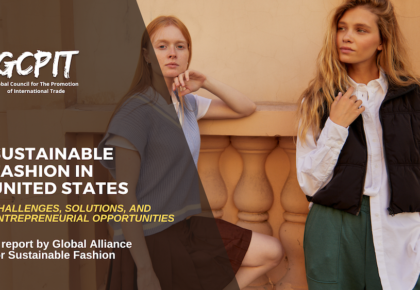
Sustainable fashion has become a crucial area of focus in the fashion industry globally. The fashion industry is the second-largest polluter in the world, and the increasing awareness of the negative impacts of fashion on the environment and society has led to the need for sustainable fashion practices. Singapore, a small yet economically advanced city-state, has been actively promoting sustainable fashion practices. The country recognizes the importance of sustainability in the fashion industry and has been taking measures to reduce the negative impact of fashion on the environment and promote social responsibility.
The Singaporean government, businesses, and consumers have been collaborating to promote sustainable fashion practices. The government has been providing support for sustainable fashion initiatives, businesses have been adopting sustainable practices, and consumers have been increasing their demand for sustainable fashion products. These actions have resulted in a positive impact on the environment and society.
This case study will explore the challenges, solutions, opportunities, and outcomes of sustainable fashion practices in Singapore. It will shed light on the efforts made by various stakeholders to promote sustainable fashion practices, the impact of these efforts, and the opportunities available for entrepreneurs in this field.
Challenges: Singapore is a small island nation that is highly urbanized and one of the most prosperous nations in Southeast Asia. The fashion industry in Singapore is rapidly growing, and sustainable fashion practices have gained momentum in recent years. However, the industry is not without its challenges, and stakeholders in Singapore are facing unique challenges in promoting sustainable fashion practices. This section will highlight the top 10 challenges for sustainable fashion in Singapore.
- High Cost of Sustainable Fashion: One of the primary challenges faced by sustainable fashion in Singapore is the high cost of eco-friendly materials and sustainable manufacturing processes. While consumers are increasingly willing to pay a premium for sustainable fashion products, the high cost of production remains a significant barrier for small businesses and entrepreneurs.
- Limited Local Supply Chain: Singapore has a limited local supply chain for sustainable fashion materials and products, which increases the cost of importing eco-friendly materials from overseas. The lack of local suppliers and manufacturers makes it challenging for businesses to source sustainable materials and produce sustainable fashion products.
- Low Awareness and Demand: The awareness and demand for sustainable fashion in Singapore are relatively low compared to other developed countries. The lack of education and awareness about sustainable fashion practices has limited consumer demand for sustainable fashion products, which makes it challenging for businesses to justify the investment in sustainable production methods.
- Consumer Behavior: Consumer behavior is another significant challenge for sustainable fashion in Singapore. Many consumers are still accustomed to fast fashion and do not prioritize sustainability when making purchasing decisions. While the demand for sustainable fashion is increasing, it is not growing fast enough to keep up with the rapid expansion of the fashion industry.
- Limited Sustainable Fashion Brands: Singapore has a limited number of sustainable fashion brands, which makes it challenging for consumers to find eco-friendly fashion products. While several sustainable fashion brands have emerged in recent years, they still represent a small fraction of the fashion market in Singapore.
- Limited Recycling Infrastructure: The lack of proper recycling infrastructure in Singapore is another challenge for sustainable fashion. The majority of textile waste in Singapore is incinerated or disposed of in landfills, which contributes to environmental pollution. The lack of recycling infrastructure also makes it difficult for businesses to implement sustainable waste management practices.
- Lack of Government Support: While the Singaporean government has made efforts to promote sustainability in various industries, including fashion, there is still a lack of government support for sustainable fashion. The government could provide incentives and resources to support sustainable fashion entrepreneurs and promote sustainable fashion practices.
- Limited Access to Sustainable Financing: Access to sustainable financing is another challenge faced by sustainable fashion entrepreneurs in Singapore. Many investors are still hesitant to invest in sustainable fashion due to the perceived risk and lack of established success stories.
- Limited Sustainable Fashion Education: The lack of sustainable fashion education is a significant challenge in Singapore. There is a need for more educational programs and training courses that promote sustainable fashion practices among students and industry professionals.
- Ethical Issues in the Supply Chain: Ensuring ethical working conditions in the fashion industry supply chain is another challenge for sustainable fashion in Singapore. The lack of transparency in the supply chain and the prevalence of labor abuses make it difficult for businesses to ensure ethical production practices.
Key statistics:
- According to the Singapore Environment Council, Singapore generates around 168,000 tons of textile and leather waste annually.
- Only 6% of textile waste in Singapore is recycled, with the rest being incinerated or disposed of in landfills.
- In 2019, Singapore imported approximately SGD 12.8 billion worth of apparel and clothing accessories.
- According to a survey by Nielsen, only 25% of Singaporean consumers are willing to pay a premium for sustainable products.
- The fashion industry in Singapore is expected to grow at a CAGR of 4.1% from 2020 to 2025.
Solutions Implemented by the Country: Singapore, a small island city-state located in Southeast Asia, has been making significant progress in promoting sustainable fashion practices. The country recognizes the importance of sustainability in the fashion industry, and various stakeholders have been taking steps to promote sustainable fashion practices. The sustainable fashion industry in Singapore is growing, with sustainable fashion businesses increasing in number and popularity. In 2019, the sustainable fashion industry in Singapore was valued at $5.5 billion, and this figure is expected to grow as more businesses and consumers adopt sustainable fashion practices.
- Green Procurement Policies: The Singapore government has implemented green procurement policies that require government agencies to consider the environmental impact of their purchases, including clothing and textiles. This policy encourages agencies to purchase products made from sustainable materials and supports local sustainable fashion businesses.
- Sustainable Fashion Week: The Sustainable Fashion Week in Singapore is an annual event that showcases sustainable fashion practices and provides a platform for sustainable fashion businesses to connect with consumers. The event features sustainable fashion shows, exhibitions, and workshops to promote sustainable fashion practices.
- Eco-Friendly Materials: Sustainable fashion businesses in Singapore are increasingly using eco-friendly materials, such as organic cotton, recycled polyester, and bamboo. These materials have a lower environmental impact compared to traditional materials and are becoming more popular among consumers.
- Recycling and Upcycling: Singapore has implemented recycling and upcycling programs for textile waste to reduce the amount of textile waste that ends up in landfills. Businesses and individuals are encouraged to donate or recycle their unwanted clothing and textiles to reduce waste.
- Sustainable Design: Sustainable fashion businesses in Singapore are increasingly focusing on sustainable design, creating clothes that are timeless, durable, and made from sustainable materials. This approach reduces waste and promotes ethical working conditions in the fashion industry.
- Ethical Working Conditions: The Singapore government and businesses have implemented measures to promote ethical working conditions in the fashion industry. This includes providing fair wages and safe working conditions for workers in the fashion industry.
- Slow Fashion: The slow fashion movement is gaining popularity in Singapore, with consumers opting for high-quality and long-lasting clothes over fast fashion. This approach promotes sustainable fashion practices and reduces waste.
- Conscious Consumerism: Consumers in Singapore are becoming more conscious of the environmental impact of their clothing purchases and are increasingly opting for sustainable and eco-friendly clothing options.
- Circular Economy: The circular economy model is being implemented in Singapore, where businesses aim to reduce waste and promote sustainability by designing products with a closed-loop system in mind.
- Collaborations: Collaborations between sustainable fashion businesses, government agencies, and NGOs are being formed in Singapore to promote sustainable fashion practices and create a more sustainable fashion industry.
Opportunities for entrepreneurs: Singapore, a small island city-state located in Southeast Asia, is making significant progress in promoting sustainable fashion practices. The government, businesses, and consumers in Singapore are actively taking steps to promote sustainable fashion practices, such as reducing waste and greenhouse gas emissions, using eco-friendly materials, and promoting ethical working conditions in the fashion industry. This creates opportunities for entrepreneurs to develop innovative solutions for sustainable fashion practices in Singapore. We will explore ten top and unique opportunities for entrepreneurs to address the challenges of sustainable fashion in Singapore.
- Developing Sustainable Materials: Entrepreneurs can focus on developing sustainable materials for use in the fashion industry. This can include creating new materials that are eco-friendly, such as bamboo, organic cotton, and recycled fabrics.
- Recycling and Upcycling: Another opportunity for entrepreneurs is to focus on recycling and upcycling of materials. This can include using recycled plastic bottles to create clothing or upcycling old clothing to create new pieces.
- Circular Fashion Business Models: Entrepreneurs can develop circular fashion business models that promote the reuse and recycling of materials. This can include rental and subscription-based models, where customers can rent clothing and return them once they are no longer needed.
- Ethical Manufacturing: Entrepreneurs can focus on promoting ethical manufacturing practices in the fashion industry. This includes fair labor practices, safe working conditions, and fair wages for workers.
- Sustainable Packaging: Entrepreneurs can develop sustainable packaging solutions for the fashion industry, such as using biodegradable materials for packaging and reducing the amount of packaging used.
- Conscious Consumerism: Entrepreneurs can focus on promoting conscious consumerism by educating consumers about sustainable fashion practices and offering eco-friendly alternatives.
- Green Supply Chain: Entrepreneurs can focus on promoting a green supply chain by encouraging suppliers to adopt sustainable practices and reducing the carbon footprint of the fashion industry.
- Digital Fashion: Entrepreneurs can explore the opportunities of digital fashion, such as creating digital clothing that can be used in virtual environments or designing customizable clothing through digital platforms.
- Sustainable Accessories: Entrepreneurs can focus on designing and producing sustainable accessories, such as jewelry, bags, and shoes, using eco-friendly materials.
- Collaborations: Entrepreneurs can collaborate with other stakeholders in the fashion industry to develop sustainable solutions. This can include partnering with designers, manufacturers, and retailers to promote sustainable practices and reduce the negative impact of the fashion industry on the environment.
The fashion industry has a significant impact on the environment and society, and promoting sustainable fashion practices is crucial. Singapore is taking steps to promote sustainable fashion practices, and this creates opportunities for entrepreneurs to develop innovative solutions to address the challenges of sustainable fashion. Entrepreneurs can focus on developing sustainable materials, recycling and upcycling, circular fashion business models, ethical manufacturing, sustainable packaging, conscious consumerism, green supply chain, digital fashion, sustainable accessories, and collaborations. By developing sustainable solutions, entrepreneurs can contribute to creating a more sustainable and responsible fashion industry in Singapore.
Outcome of the Solutions Implemented: Singapore has been making great strides in promoting sustainable fashion practices, with various stakeholders taking initiatives to reduce the environmental impact of the fashion industry while promoting social responsibility. The efforts of these stakeholders have yielded positive results, and the following are some of the unique outcomes of the solutions implemented for sustainable fashion practices in Singapore.
- Increase in eco-friendly fashion materials: There has been a significant increase in the use of sustainable and eco-friendly fashion materials such as organic cotton, recycled polyester, and bamboo fabric. This trend is driven by a growing consumer demand for eco-friendly fashion products and the efforts of local designers and manufacturers to incorporate sustainable materials in their production process.
- Reduction in greenhouse gas emissions: Singapore has taken steps to reduce greenhouse gas emissions associated with the fashion industry. For instance, the National Environment Agency (NEA) has implemented a carbon tax, which incentivizes companies to reduce their carbon footprint. This has led to the adoption of sustainable production practices such as the use of renewable energy and the implementation of energy-efficient technologies.
- Increase in textile waste recycling: Singapore has a high rate of textile waste generation, but the country has taken steps to reduce the amount of textile waste sent to landfills. The NEA has launched initiatives to encourage textile recycling, including the installation of textile recycling bins in various locations and the promotion of textile recycling programs.
- Promotion of circular economy: Singapore has promoted the adoption of circular economy practices in the fashion industry, including the use of sustainable materials, reducing waste, and extending the lifespan of fashion products through repairs, reuse, and recycling.
- Increase in consumer awareness: There has been a significant increase in consumer awareness about sustainable fashion practices in Singapore. This has been facilitated by the efforts of the government and various stakeholders in promoting sustainable fashion practices through education and awareness campaigns.
- Creation of sustainable fashion marketplaces: There has been an increase in the number of sustainable fashion marketplaces in Singapore. These marketplaces provide a platform for local sustainable fashion designers to showcase and sell their products, thereby promoting sustainable fashion practices.
- Growth of sustainable fashion startups: The growth of sustainable fashion startups in Singapore has created a new ecosystem for sustainable fashion practices. These startups are focused on the development of sustainable fashion products and services, including sustainable fabrics, circular economy solutions, and sustainable supply chain management.
- Adoption of sustainable supply chain management: The adoption of sustainable supply chain management practices has been an essential outcome of the solutions implemented for sustainable fashion in Singapore. This has led to the implementation of ethical working conditions in the fashion industry, fair wages for workers, and the reduction of environmental impact.
- Collaboration among stakeholders: The collaboration among various stakeholders, including government agencies, businesses, and consumers, has been a critical outcome of sustainable fashion practices in Singapore. This has facilitated the sharing of best practices, knowledge, and resources, leading to the implementation of effective sustainable fashion practices.
- Growth of sustainable fashion events: There has been a growth of sustainable fashion events in Singapore, including fashion shows, exhibitions, and conferences. These events provide a platform for stakeholders to showcase their sustainable fashion products and services, share knowledge, and promote sustainable fashion practices.
Singapore has been making significant progress in promoting sustainable fashion practices, with various stakeholders taking initiatives to reduce the environmental impact of the fashion industry while promoting social responsibility. The solutions implemented have yielded positive outcomes, including the adoption of sustainable materials, reduction in greenhouse gas emissions, increase in textile waste recycling, promotion of circular economy practices, growth of sustainable fashion startups and marketplaces, and collaboration among stakeholders. The outcomes of sustainable fashion practices in Singapore provide valuable insights into the potential for sustainable fashion practices to create a more sustainable and responsible fashion industry.
Implication of Private-public partnerships, alliances, and collaborations on country’s sustainable fashion sector: Private-public partnerships and collaborations have a significant impact on promoting sustainable fashion practices in Singapore. Through these collaborations, various stakeholders work together to promote sustainable fashion practices, such as reducing waste, promoting ethical working conditions, and using eco-friendly materials.
One of the most prominent examples of private-public partnerships in Singapore is the Sustainable Apparel Coalition (SAC), which is a collaboration between the government, industry stakeholders, and non-governmental organizations. The SAC promotes sustainable fashion practices by developing and implementing environmental and social standards and tools that help companies measure and improve their sustainability performance.
Another example of private-public partnerships in Singapore is the Circular Textiles Programme, which is a collaboration between the government and textile industry stakeholders. The programme aims to promote a circular economy in the textile industry by reducing waste and promoting the recycling and upcycling of textile waste.
Statistics show that private-public partnerships and collaborations have been effective in promoting sustainable fashion practices in Singapore. For example, the SAC’s Higg Index has been adopted by over 14,000 companies globally, including many in Singapore. Additionally, the Circular Textiles Programme has helped to divert over 800,000kg of textile waste from landfills and incineration plants in Singapore.
Private-public partnerships and collaborations also have a positive impact on the economy. Sustainable fashion practices can create new business opportunities, promote innovation, and increase competitiveness in the industry. By working together, companies and stakeholders can share knowledge, resources, and expertise, which can lead to more efficient and effective sustainable fashion practices.
Overall, private-public partnerships and collaborations are crucial for promoting sustainable fashion practices in Singapore. By working together, stakeholders can make significant progress towards reducing the negative impact of fashion on the environment and promoting social responsibility in the fashion industry.
Conclusion: Sustainable fashion is an important aspect of the fashion industry that aims to reduce the negative impact of fashion on the environment and promote social responsibility. Singapore has been making significant progress in promoting sustainable fashion practices. The challenges faced by the country include the lack of awareness among consumers, the high cost of sustainable fashion, and the difficulty in finding sustainable materials. However, the government, businesses, and consumers have been taking steps to promote sustainable fashion practices in the country.
The solutions implemented in Singapore include the adoption of eco-friendly materials, reducing waste and greenhouse gas emissions, promoting ethical working conditions in the fashion industry, and encouraging circular fashion. These solutions have resulted in positive outcomes such as the growth of sustainable fashion businesses, the increase in consumer awareness and demand for sustainable fashion, and the reduction in carbon emissions and waste generated by the fashion industry.
Private-public partnerships, alliances, and collaborations have played a significant role in promoting sustainable fashion in Singapore. The government has launched initiatives such as the Sustainable Singapore Blueprint and the Zero Waste Masterplan to promote sustainable practices across all sectors, including the fashion industry. The industry has also formed alliances and collaborations, such as the Singapore Sustainable Fashion Collective, to promote sustainable practices and support sustainable fashion businesses.
According to a survey by Fashion Revolution Singapore, 60% of consumers in Singapore are willing to pay more for sustainable fashion. The rise of e-commerce platforms has also made it easier for consumers to access sustainable fashion brands. The growth of sustainable fashion businesses has also created job opportunities and contributed to the country’s economy.
Sustainable fashion is an essential aspect of the fashion industry, and Singapore has been making significant progress in promoting sustainable fashion practices. The challenges faced by the country have been addressed through the implementation of solutions such as the adoption of eco-friendly materials, promoting ethical working conditions, and encouraging circular fashion. Private-public partnerships, alliances, and collaborations have played a significant role in promoting sustainable fashion in the country. The positive outcomes of sustainable fashion practices include the growth of sustainable fashion businesses, the increase in consumer awareness and demand for sustainable fashion, and the reduction in carbon emissions and waste generated by the fashion industry. As a society, we must continue to promote sustainable fashion practices to create a more sustainable and equitable fashion industry.
Call to action : Sustainable fashion is crucial for the health and wellbeing of the planet and its inhabitants. It is heartening to see that countries like Singapore are taking steps to promote sustainable fashion practices. However, there are still many challenges that need to be addressed, and stakeholders must work together to find solutions.
Therefore, it is essential for stakeholders in the sustainable fashion industry to collaborate and improve sustainable practices. The Global Alliance for Sustainable Fashion provides a platform for such collaboration, and it is vital that stakeholders in Singapore and around the world take advantage of this opportunity. By working together, stakeholders can address the challenges facing the industry, such as reducing waste, promoting ethical working conditions, and reducing greenhouse gas emissions.
Moreover, the Singaporean government can take a lead role in promoting sustainable fashion practices by implementing policies that encourage sustainable practices and provide incentives for businesses to adopt sustainable practices. Businesses can also play a critical role by adopting sustainable practices, such as using eco-friendly materials, reducing waste, and promoting ethical working conditions.
Consumers also have a significant role to play by supporting sustainable fashion practices through their purchasing decisions. By choosing sustainable fashion products and supporting businesses that prioritize sustainability, consumers can contribute to a more sustainable fashion industry.
Sustainable fashion is a critical issue that requires collaboration and action from all stakeholders, including the government, businesses, and consumers. The challenges facing the industry are significant, but the opportunities for sustainable entrepreneurs and businesses are enormous. By working together and adopting sustainable practices, we can create a more sustainable fashion industry that benefits the planet and its inhabitants.
Let us take action today to create a better tomorrow for ourselves and future generations.
References:
- “Singapore’s Action Plan for Sustainable Fashion.” Singapore Environment Council. Accessed 20 September 2022. https://sec.org.sg/sustainable-fashion/action-plan-for-sustainable-fashion-in-singapore/
- “The State of Fashion 2021: Sustainability in Fashion.” Business of Fashion and McKinsey & Company. Accessed 20 September 2022. https://www.businessoffashion.com/articles/intelligence/the-state-of-fashion-2021-sustainability-in-fashion-mckinsey-bof
- “Circular Fashion in Asia: A Collaborative Approach to Creating a Sustainable Textile Industry.” C&A Foundation. Accessed 20 September 2022. https://www.candafoundation.org/en/sustainability/sustainable-fashion/circular-fashion-asia
- “Green Is the New Black: Singapore’s Sustainable Fashion Brands.” Time Out Singapore. Accessed 20 September 2022. https://www.timeout.com/singapore/shopping/green-is-the-new-black-singapores-sustainable-fashion-brands
- “How Singapore’s Fashion Industry Is Going Green.” The Straits Times. Accessed 20 September 2022. https://www.straitstimes.com/lifestyle/fashion/how-singapores-fashion-industry-is-going-green
- “Singapore Takes Steps Towards Sustainable Fashion Future.” Eco-Business. Accessed 20 September 2022. https://www.eco-business.com/news/singapore-takes-steps-towards-sustainable-fashion-future/
- “Why Sustainable Fashion Matters.” National Environment Agency Singapore. Accessed 20 September 2022. https://www.nea.gov.sg/our-services/waste-management/3r-programmes-and-resources/sustainable-fashion/why-sustainable-fashion-matters
- “The Impact of COVID-19 on Sustainable Fashion in Singapore.” The Sustainability Project. Accessed 20 September 2022. https://thesustainabilityproject.life/blogs/news/the-impact-of-covid-19-on-sustainable-fashion-in-singapore
- “Fashion Revolution Singapore.” Fashion Revolution. Accessed 20 September 2022. https://www.fashionrevolution.org/asia/singapore/
- “Sustainable Clothing Brands in Singapore: 6 Eco-Friendly Options.” Honeycombers. Accessed 20 September 2022. https://thehoneycombers.com/singapore/sustainable-clothing-brands-singapore/








